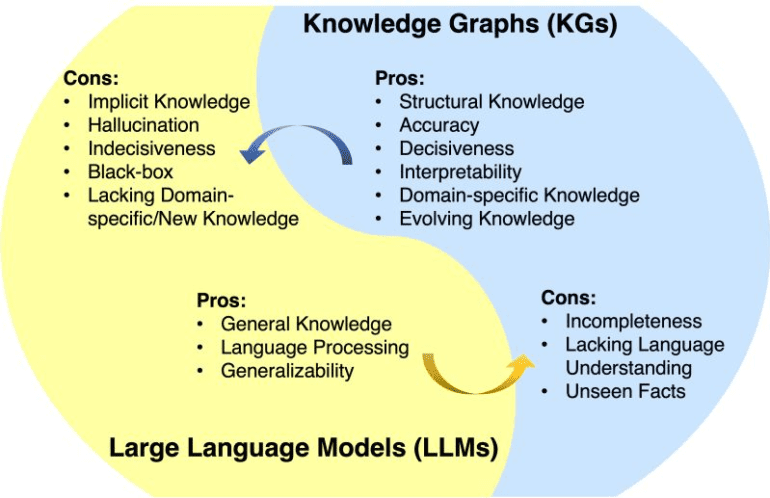TL;DR:
- Neo4j, a pioneer in graph database technology, plays a vital role in fueling generative AI.
- They provide high-quality, structured graph data to large language models (LLMs) for training.
- Knowledge graphs are essential for organizing and accessing enterprise data, and Neo4j facilitates their integration with LLMs.
- Neo4j’s Graph Data Science framework offers advanced graph analytics and data science capabilities.
- By leveraging graph algorithms and predictive features, organizations can gain valuable insights and solve complex problems.
- Neo4j’s Cypher simplifies data retrieval from graphs, enabling users to focus on obtaining the desired information.
- The integration of LLMs with Neo4j’s graph database enhances efficiency and accuracy in data handling.
- Neo4j’s approach aims to make data more accessible, understandable, and credible.
- The combination of curated knowledge from Neo4j and machine learning models provides trustworthy and validated answers.
- LLMs act as productivity enhancers, allowing non-technical users to interact with technology through natural language.
Main AI News:
Generative AI, a cutting-edge technology, relies heavily on databases and data structure servers to unleash its full potential. In this transformative landscape, database companies are leading the way, driving the progress of generative AI. From Redis, empowering LLM-powered chatbots like ChatGPT, to MongoDB Atlas and Google Cloud Vertex AI PaLM API, integrated by enterprises for chatbot development, these companies are at the forefront of the generative AI revolution.
Among these trailblazers stands Neo4j, a pioneer in graph database technology, taking a strategic approach and playing the long game to establish trust in generative AI. “We offer the essential fuel for generative AI companies in the form of high-quality, structured graph data,” revealed Dr. Jim Webber, Neo4j’s esteemed chief data scientist, during an exclusive interview with AIM at the Annual Graph Summit held in Mumbai last week.
Neo4j’s key contribution lies in providing large language models (LLMs) with crucial graph data for training. Over time, knowledge graphs have emerged as indispensable tools for organizing and accessing enterprise data across various industries. Today, Neo4j plays a pivotal role in assisting enterprises in integrating LLMs, thereby enhancing data handling capabilities. The company is focused on two primary use cases: developing a natural language interface for knowledge graphs and creating knowledge graphs from unstructured data.
To accomplish these goals, Neo4j’s Graph Data Science framework offers a suite of advanced graph analytics and data science capabilities. It encompasses a flexible toolkit, a scalable graph database, and a powerful visualization tool. By harnessing these tools, businesses can leverage graph algorithms and predictive features to make accurate predictions, solve intricate problems, and extract valuable insights. Neo4j’s Cypher, a graph query language resembling SQL, simplifies data retrieval from graphs, allowing users to concentrate on obtaining the desired information.
According to Webber, Neo4j’s ultimate aim is to make data more accessible, understandable, and credible. By integrating LLMs with Neo4j’s graph database technology, efficiency and accuracy are greatly improved. This project embraces an open mindset, adapting to new data and technological advancements in the rapidly evolving field of AI. Webber emphasizes the significance of the convergence between knowledge representation and machine learning in advancing AI to new frontiers.
Dr. Jesus Barrasa, Head of Solutions Architecture at Neo4j, explains that Neo4j embodies comprehensive knowledge about a particular domain, providing carefully curated and explainable answers. On the other hand, machine learning models learn from vast datasets and generate plausible but unexplainable answers.
“The combination of these approaches is truly advantageous,” states Barrasa. He highlights that while machine learning models can distill vast amounts of knowledge, they often lack curation and trust. By integrating curated knowledge from Neo4j with machine learning models, users gain the ability to ask questions with confidence and validation. LLMs serve as productivity enhancers, facilitating rapid code generation and data analysis for populating knowledge graphs. Moreover, they empower non-technical users to interact with technology by generating structured questions from natural language.
Conclusion:
Neo4j’s significant role in fueling generative AI through graph technology has profound implications for the market. Their provision of high-quality, structured graph data to large language models enhances the capabilities and efficiency of data handling. The integration of Neo4j’s Graph Data Science framework empowers businesses to extract valuable insights, solve complex problems, and make accurate predictions. By combining curated knowledge with machine learning models, Neo4j ensures the trustworthiness and credibility of the generated answers. This convergence of graph technology and AI represents a transformative force in the market, enabling organizations to unlock new possibilities and drive innovation in various industries. The strategic approach and dedication of Neo4j position them as trusted partner in the generative AI revolution, shaping the future of the market.

